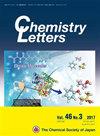甲醇脱氢酶中配体结合的分子动力学计算见解
IF 1.1
4区 化学
Q3 CHEMISTRY, MULTIDISCIPLINARY
引用次数: 0
摘要
甲醇脱氢酶是一种很有前途的工业生物催化剂,可将甲醇转化为甲醛。我们的分子模型显示,甲醇与甲醇脱氢酶的结合自由能为∼7 kcal/mol,而甲醛与甲醇脱氢酶的结合自由能为∼4 kcal/mol。这表明甲醇在活性位点停留的时间更长,而甲醛在反应后更容易排出。这些见解对于设计工业应用中更高效的甲醇脱氢酶变体至关重要。本文章由计算机程序翻译,如有差异,请以英文原文为准。
Computational insights into the molecular dynamics of the binding of ligands in the methanol dehydrogenase
Methanol dehydrogenase is a promising biocatalyst for industrial use, converting methanol to formaldehyde. Our molecular modeling revealed methanol binds to methanol dehydrogenase with ∼7 kcal/mol free energy, while formaldehyde binds with ∼4 kcal/mol. This suggests that methanol remains longer in the active site, and formaldehyde exits more readily postreaction. These insights are crucial for designing more efficient methanol dehydrogenase variants for industrial applications.
求助全文
通过发布文献求助,成功后即可免费获取论文全文。
去求助
来源期刊

Chemistry Letters
化学-化学综合
CiteScore
3.00
自引率
6.20%
发文量
260
审稿时长
1.2 months
期刊介绍:
Chemistry Letters covers the following topics:
-Organic Chemistry-
Physical Chemistry-
Inorganic Chemistry-
Analytical Chemistry-
Materials Chemistry-
Polymer Chemistry-
Supramolecular Chemistry-
Organometallic Chemistry-
Coordination Chemistry-
Biomolecular Chemistry-
Natural Products and Medicinal Chemistry-
Electrochemistry
 求助内容:
求助内容: 应助结果提醒方式:
应助结果提醒方式:


